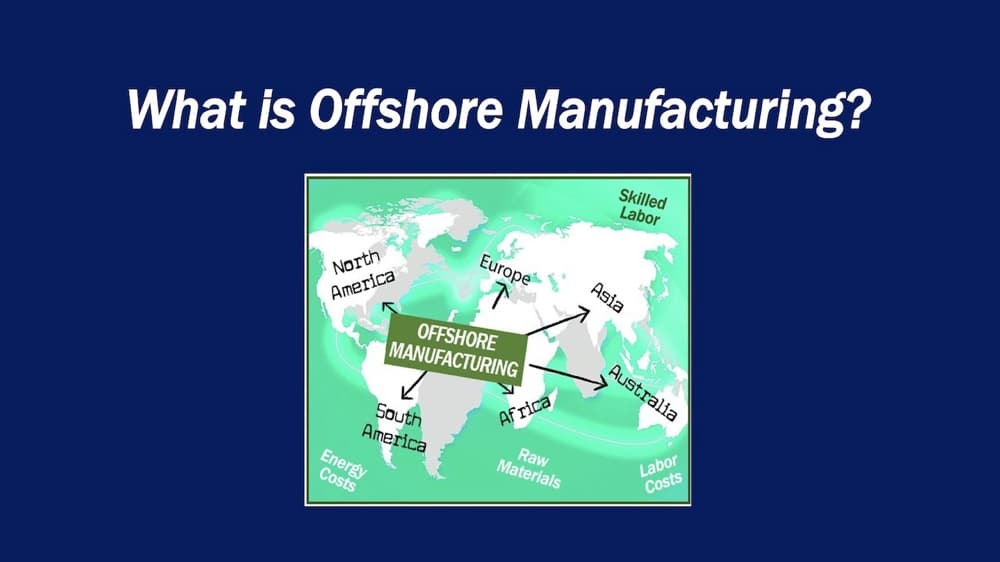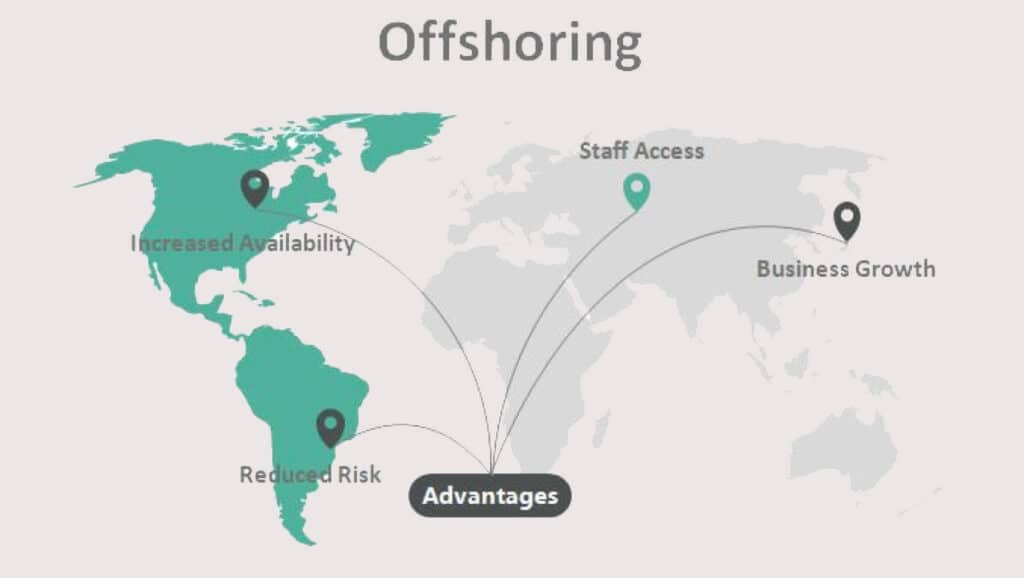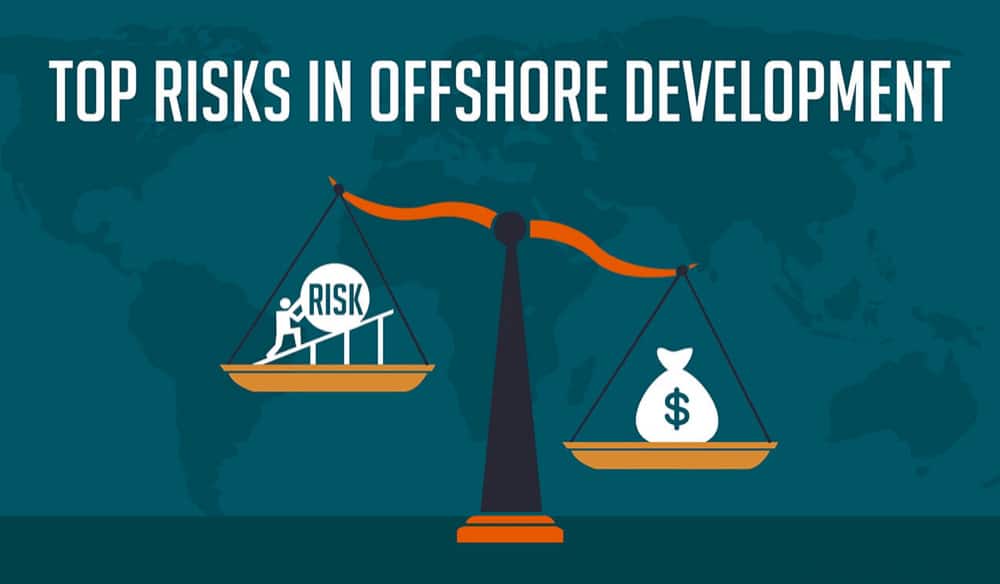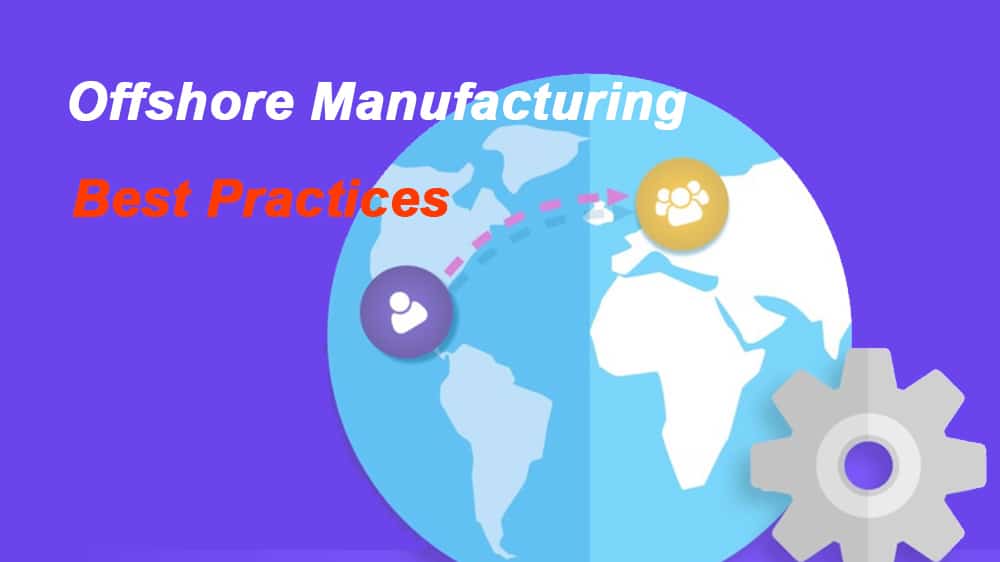
Offshore manufacturing means producing or assembling goods in a country other than your home market to access cost advantages, capabilities, or capacity. It is a location decision (where the work happens) and can be done by your own subsidiary (captive) or by third‑party factories.
In other words: offshoring changes the map; outsourcing changes who does the work. Policy bodies draw this distinction clearly—relocation (offshoring/reshoring) versus governance (outsourcing/insourcing)—as summarized in the OECD’s 2024 synthesis on offshoring and reshoring dynamics (OECD 2024 overview of offshoring/reshoring).
UNCTAD also documents how “friend‑shoring” has entered the vocabulary as firms reconfigure supply chains toward politically aligned locations (UNCTAD 2023 friend‑shoring paper).
Offshore vs. Outsourcing vs. Nearshoring vs. Reshoring vs. Friend‑shoring

- Offshore manufacturing (offshoring): Producing in a foreign country. May be captive or contracted. See the policy framing in the OECD’s 2024 report above.
- Outsourcing: Hiring an external provider to perform work, regardless of location. You can outsource domestically or offshore in‑house.
- Nearshoring: Offshoring to a nearby country to reduce transit times and risk (e.g., U.S. → Mexico). The OECD’s 2024 brief outlines Mexico’s nearshoring dynamics and constraints (OECD 2024 nearshoring in Mexico brief).
- Reshoring: Bringing production back to the home country—literally reversing prior offshoring—matching the plain‑language definition in the Cambridge Dictionary entry for “reshore”.
- Friend‑shoring: Building supply chains in politically aligned or trusted countries to reduce geopolitical exposure (see the UNCTAD 2023 working paper cited above).
What offshore manufacturing is not:
- Not automatically low quality—quality depends on supplier capability and controls.
- Not always cheapest once you include total landed cost (tooling, logistics, tariffs, defects/returns, and inventory carrying cost).
- Not synonymous with outsourcing—you can outsource locally or offshore in‑house.
When Offshore Manufacturing Makes Sense (Decision Factors & KPIs)

Look beyond unit price and evaluate the full system.
Key decision factors:
- Capability access: Specialized tooling, components, automation, or craftsmanship not available domestically. Many practitioners note China’s unmatched supplier density and tooling ecosystem even as firms diversify, a theme discussed in Plante Moran’s 2024 China‑plus strategy insight (Plante Moran 2024 China‑plus strategy).
- Volume, MOQs, and tooling: Larger runs amortize molds and setups better; small batches may benefit from flexible plants and faster lanes.
- Lead‑time tolerance: Your ability to buffer demand with inventory, express options, or dual‑mode shipping.
- Policy and tariff exposure: Current and potential duties, safeguards, or carbon policies (see CBAM below) that change landed cost.
- Compliance requirements: Product safety, social compliance, and forced‑labor due diligence (e.g., UFLPA for U.S. imports).
KPIs that keep decisions honest:
- Total landed cost per unit (all‑in, including logistics, duties, quality costs, and inventory).
- First‑Pass Yield (FPY): Share of units that pass all checks the first time—a core process effectiveness lens consistent with ISO 9001’s quality management principles (ISO 9001 principles, ISO).
- Defect/return rate: Track defects using acceptance sampling plans such as ANSI/ASQ Z1.4; use rates to trigger corrective actions (ASQ overview of Z1.4 acceptance sampling).
- OTIF (On‑Time In‑Full): The percentage of orders delivered when promised and in full quantity—a standard service metric in retail and manufacturing operations.
- Lead‑time variance: How far actuals deviate from plan (crucial for cash and inventory).
The Risks—and How to Mitigate Them

Quality drift and inconsistency
- What can go wrong: Process variation on critical dimensions; “quality fade” after initial runs.
- Mitigations: Golden‑sample sign‑off, unambiguous specs/BOMs, acceptance sampling at agreed AQL levels (ANSI/ASQ Z1.4; ISO 3951), and corrective action loops aligned with ISO 9001’s continual improvement (ASQ acceptance sampling explainer; ISO 9001 principles).
Intellectual property (IP) leakage
- What can go wrong: Unauthorized use of designs, molds, or brand assets.
- Mitigations: China‑specific NNN agreements (Non‑Disclosure/Non‑Use/Non‑Circumvention) executed before disclosure, staged release of drawings/BOMs, tooling ownership clauses, and document control. Practitioners often reference specialist guidance such as Harris Bricken’s coverage of enforceable NNN terms under PRC law (Harris Bricken on China NNN agreements).
Tariffs, carbon policies, and rules of origin
- What can go wrong: Misclassification, surprise duties, or origin rules that upend preferential rates.
- Mitigations: HS code reviews, origin planning, scenario modeling (FOB vs. DDP), and (where applicable) bonded/FTZ strategies. In the EU, the Carbon Border Adjustment Mechanism requires embedded‑emissions reporting in its transitional phase and will require purchasing CBAM certificates from 2026 onward (see the European Commission’s CBAM overview and FAQs: EC CBAM overview; EC CBAM FAQs, Nov 2023).
Forced‑labor due diligence (U.S. UFLPA)
- What can go wrong: Detentions or exclusions if you cannot evidence supply‑chain cleanliness.
- Mitigations: Maintain traceable documentation (BOMs to raw materials, supplier contracts, invoices, transport docs, and affidavits) consistent with U.S. Customs and Border Protection guidance in the Uyghur Forced Labor Prevention Act program hub (CBP UFLPA official page).
Logistics shocks and freight volatility
- What can go wrong: Geopolitical rerouting, carrier capacity swings, port congestion.
- Mitigations: Sea+air splits, PO phasing, safety stock, carrier diversification, and dynamic routing. For current ocean‑freight context and volatility drivers, see the weekly World Container Index maintained by Drewry (Drewry WCI weekly index) and 2025 risk briefings from Xeneta (Xeneta 2025 supply chain risks).
China and the China+1 Reality

- Depth and density still matter: China’s supplier clusters, tooling ecosystem, and component availability remain hard to match for many categories—even as firms diversify. A practitioner perspective on balancing risk and capability appears in Plante Moran’s 2024 China‑plus strategy.
- Diversification is real but nuanced: U.S. reshoring and foreign direct investment announcements surged in recent years. The Reshoring Initiative’s 2024 Annual Report (published June 2025) notes about 244,000 U.S. jobs announced in 2024, underscoring footprint shifts alongside offshore strategies (Reshoring Initiative 2024 Annual Report).
- Friend‑shoring and regional options: An IMF working paper (2024) estimates that reshoring carries larger long‑run GDP costs than friend‑shoring, highlighting the trade‑offs in footprint design (IMF 2024 de‑risking scenarios working paper). Viet Nam’s continued FDI inflows and export orientation illustrate its China+1 role, as discussed in the OECD’s 2025 Economic Survey of Viet Nam (OECD 2025 Viet Nam survey — trade and investment flows).
Bottom line: treat your manufacturing footprint like a portfolio. Many brands keep critical components or tooling in China while placing selected assemblies or SKUs in Viet Nam, India, Thailand, or Mexico to balance cost, capability, and risk.
How Yansourcing De‑risks Offshore Manufacturing

Yansourcing is a China‑based sourcing and supply‑chain partner that helps international brands plan and execute offshore manufacturing from factory discovery to delivery.
What we handle end‑to‑end:
- Supplier verification and factory audits: Capability matching, certification checks, on‑site assessments, and reference validation.
- IP safeguards workflow: Coordinate China‑specific NNN execution with your counsel, control BOM/drawing disclosure by stage, and define tooling/mold ownership terms.
- Quality assurance: Sample management, golden‑sample sign‑off, inline and pre‑shipment inspections with AQL plans, and corrective‑action follow‑up aligned to ISO‑style practices.
- Production follow‑up: Milestone gating, timeline tracking, expediting, and transparent status reporting to protect OTIF.
- Logistics and customs orchestration: Incoterms advice, freight booking, documentation packs, and UFLPA/traceability packet preparation; multi‑warehouse and FBA prep for e‑commerce.
- Private label and e‑commerce solutions: Packaging, labeling, barcode/carton requirements, and product‑testing coordination.
KPIs we help you track from PO to delivery:
- Total landed cost per unit, FPY, defect/return rate, OTIF, and lead‑time variance.
Ready to talk through your project? Book a free consultation or request a sourcing quote at Yansourcing.
A Practical Kickoff Checklist (China Edition)

- Clarify objectives: cost‑to‑serve target, lead‑time tolerance, quality thresholds, compliance scope.
- Define specs and documentation: drawings, BOM, tolerances, packaging, labeling, and testing standards.
- Protect IP early: NNN agreement in place; tooling ownership terms drafted; staged disclosure plan.
- Shortlist and verify suppliers: capability match, audit results, certifications validated, trial orders planned.
- Quality plan: golden sample, inspection stages (inline/pre‑shipment), AQL levels, CAPA process.
- Logistics plan: Incoterms, lanes (ocean/air/rail), buffers, sea+air splits, carton/pallet specs, FBA/3PL requirements.
- Compliance pack: product safety tests, social compliance evidence, UFLPA traceability docs, and (if EU) CBAM awareness for covered sectors.
- KPI dashboard: FPY, defect/return rate, OTIF, lead‑time variance, and total landed cost.
FAQs
Is offshore manufacturing still cheaper?
It can be—but only after you account for total landed cost, tariffs, quality costs, and inventory. Policy shifts can change the math; for example, the EU’s CBAM introduces carbon‑based costs from 2026 for certain sectors (EC CBAM overview).
How do I protect my IP in China?
Use China‑specific NNN agreements, define tooling ownership, and disclose designs in stages. Many importers follow best‑practice guidance such as the legal frameworks discussed by Harris Bricken for enforceable NNNs under PRC law (Harris Bricken on China NNN agreements).
What does UFLPA mean for my imports to the U.S.?
Be ready to prove the provenance of materials—CBP outlines documentation expectations under the Uyghur Forced Labor Prevention Act program (CBP UFLPA official page).
Why is everyone talking about China+1?
Companies are balancing risk and capability. Some production is reshoring or nearshoring—U.S. job announcements tied to reshoring/FDI reached 244,000 in 2024 per the Reshoring Initiative’s latest annual report (published 2025)—while others expand into Viet Nam/India/Thailand to complement China’s depth (Reshoring Initiative 2024 Annual Report; OECD 2025 Viet Nam survey).
If you’re weighing offshore manufacturing for your next product, Yansourcing can help you validate suppliers, protect your IP, lock in quality, and deliver compliantly.
